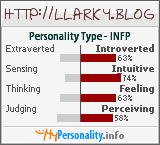However, people vary tremendously: a generally serotonin-related condition can be highly serotonin-related for one person but entirely unrelated for another. Tiral and error with at least one or two serotonergic approaches (one can work where others fail) is usually the only way to find out which of these groups a person belongs to.
1. Serotonin is produced in the Pineal gland.

2. The average adult human possesses only 5 to 10 mg of serotonin, 90 % of which is in the intestine and the rest in blood platelets and the brain.
3. Neurotransmitter - the control of appetite, sleep, memory, and learning, temperature regulation, mood, behavior, cardiovascular function, muscle contraction, endocrine regulation and depression.
4. "no physiological substance known possesses such diverse actions in the body as does serotonin".
5. It's also found in wasp stings and scorpion venom where its function is of an irritant, since intravenous injection of serotonin in humans leads to pain, gasping, coughing, a tingling and prickling sensation, nausea, cramps and other unpleasant symptoms.
6. Manufactured in the human brain using the essential amino acid tryptophan found in foods like bananas, pineapples, plums, turkey and milk

7. The enzyme tryptophan hydroxylase adds a hydroxyl group to tryptophan's benzene ring at position 5, creating 5-hydroxytryptophan. Another enzyme, amino acid decarboxylase, then removes a carboxyl group from 5-hydroxytryptophan, forming 5-hydroxytryptamine which is more commonly known as serotonin.
8. Serotonin is a neurotransmitter involved in the transmission of nerve impulses.
9. Packets of serotonin (vesicles) are released from the end of the presynaptic cell into the synaptic cleft. The serotonin molecules can then bind to receptor proteins within the postsynaptic cell, which causes a change in the electrical state of the cell. This change in electrical state can either excite the cell, passing along the chemical message, or inhibit it. Excess serotonin molecules are taken back up by the presynaptic cell and reprocessed.
10. The neurons in the brain that release serotonin are found in Raphe Nuclei(medulla, pons and midbrain)
11. Serotonergic neurons have axons which project to many different parts of the brain, therefore serotonin affects many different behaviors.
12. Depression CAN be a result of serotonin deficiency. - Anti-depressant medications increase serotonin levels at the synapse by blocking the reuptake of serotonin into the presynaptic cell.
13. Serotonin levels can increase with vigorous exercise
14. A diet deficient in omega-3 fatty acids may lower brain levels of serotonin and cause depression.
Complex carbohydrates raise the level of tryptophan in the brain resulting in a calming effect.
Vitamin C is also required for the conversion of tryptophan into serotonin.
Source: Claire Rosling from University of Bristol

No hay comentarios:
Publicar un comentario